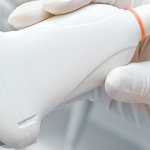In a study of about 900 patients, researchers at her center found that while ACPA-positive, rheumatoid factor-positive RA patients had a distinct HLA genetics profile not seen in seronegative RA, and that lupus patients could be subdivided into subgroups based on their autoantibody makeup and on HLA genetics, lupus arthritis patients were not easily distinguished.3
“Even though lupus arthritis was very much a part of this big analysis, the lupus arthritis group does not form its own subgroup,” Dr. Malmstrom said.
She said the “old dogma” held that lupus arthritis was not particularly erosive, but that perception has changed.
“Better imaging is showing that lupus arthritis can be erosive,” she said. What is more, she said, arthritis, tendonitis and tenosynovitis in lupus have probably tended to be underestimated by traditional clinical assessments.
“There’s so much excitement now with all this new imaging, new ways of studying patient material,” she said.
In a study of samples from a synovial fluid (SF) biorepository in Stockholm—with patients having a wide range of organ involvement and autoantibodies representative of lupus at large—researchers at her center tried to get a handle on the features that can distinguish lupus arthritis in this fluid.4
Among the observations were that IL6 is enriched in the SF compared to serum, with some patients having high values of IL17A and IL10 in the SF, while IL4 and IL2 were higher in the circulation. They also found that B cells comprised less than 1% of the mononuclear cells, “so it doesn’t seem like in synovial fluid that B cells are the main driver of the arthritis that we see.”
In their T cell analysis, researchers found that CCR6, a chemokine associated with TH17, was prominent, but this was also seen in spondyloarthritis and RA. Interferon gamma was most abundantly produced, Dr. Malmstrom said.
“There are many similarities and differences, and there are many things that we do not yet know about lupus arthritis,” she said.
Knowledge Gaps
Kenneth Kalunian, MD, the Wolfe Family Director of the University of California, San Diego Lupus Center of Excellence, noted how literature reviews have repeatedly identified knowledge gaps when it comes to how to best treat lupus arthritis.
The pathogenesis of LA has come into sharper focus but work remains to be done, and it’s still not clear on how it is best diagnosed.




